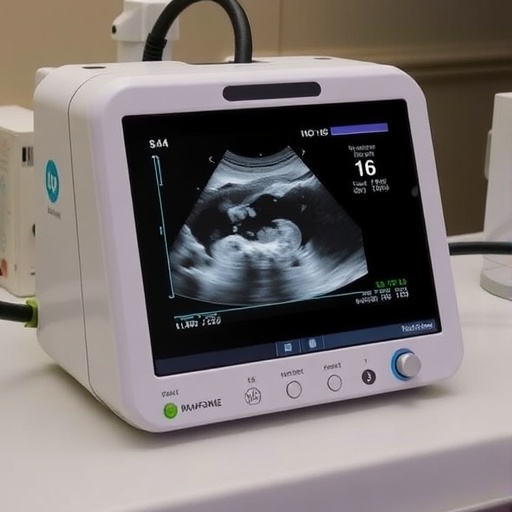In a remarkable leap forward in biomedical engineering, researchers have unveiled a state-of-the-art miniature A-mode ultrasound system designed specifically for non-invasive acquisition of bone surface point clouds. This pioneering technology presents an innovative approach to studying the microarchitecture of bones, moving away from traditional and often invasive procedures. By harnessing the capabilities of ultrasound, which is widely celebrated for its versatility, the researchers aim to bring about a paradigm shift in how bone health and diseases are assessed, particularly in patients who are unable to undergo conventional imaging techniques.
The novel ultrasound system boasts an impressive design, smaller than anything currently utilized in clinical settings. This compact form factor enhances its portability and user-friendliness, making it an invaluable tool for both practitioners and researchers. Enabled by versatile signal processing algorithms, the system not only ensures high-quality imaging but also significantly improves the precision of the point cloud data obtained. This advancement is critical in the field of orthopedics and rehabilitation, where detailed understanding of bone geometry can directly influence treatment decisions and outcomes.
Bone health is an area of critical concern, especially with the increasing aging population and the rise in conditions such as osteoporosis. Traditional imaging techniques, such as X-rays or CT scans, have provided insightful data but often come with inherent risks such as radiation exposure and invasive procedures. The unveiling of this ultrasound system, therefore, could not have come at a better time. Patients will benefit from a safer, non-invasive option that enables health care providers to perform detailed assessments of bone condition without the associated risks of radiation.
The researchers developed this breakthrough technology to cater specifically to the demands of modern medicine, where both accuracy and patient comfort are paramount. One of the standout features of the miniature A-mode ultrasound system is its remarkable ability to generate three-dimensional point clouds of bone surfaces. This attribute allows for a comprehensive analysis that was previously difficult to achieve with standard imaging modalities. By providing detailed geometric information, the system opens up new avenues for research and clinical practices centered around skeletal health.
A significant aspect of this research is the signal processing methodology employed, which is integral to the system’s performance. Advanced algorithms manipulate the ultrasound signals to enhance clarity and reduce interference, producing images that are both reliable and informative. The implication of having exceptionally clear and accurate images cannot be understated; this advancement can lead to much better-targeted interventions in clinical settings. Furthermore, the system’s rapid processing speed ensures that real-time assessments can be performed during examinations, catering to the fast-paced nature of modern medical environments.
Implementing this technology in clinical practice could greatly improve diagnostics surrounding a myriad of bone-related conditions. For instance, it holds particular promise for evaluating the effectiveness of treatments for diseases such as osteoporosis and metastatic bone disease. Clinicians will have the capability to monitor changes in bone surface geometry with a non-invasive method, allowing for more frequent assessments without the drawbacks tied to traditional imaging. As a result, therapy adjustments can be made earlier, optimizing patient care and recovery processes.
Beyond its practical applications in clinics, this ultrasound system also signifies a tremendous leap in research capabilities. The ability to gather accurate point clouds of bone surfaces will allow scientists to dive deeper into the nuances of bone diseases and fractures. Researchers can now study bone’s biomechanical properties and the impact of various interventions with unprecedented precision. By creating a clearer picture of how different factors affect bone health, this innovation promotes a more in-depth understanding of osteology and pathology.
Nonetheless, integrating this advanced technology into routine clinical practice does not come without challenges. Ensuring that healthcare professionals are trained to operate the device efficiently is essential. Furthermore, regulatory approvals and the establishment of standardized protocols for its use will be necessary to ensure patient safety. Collaborative efforts between engineers, clinicians, and medical institutions are crucial to facilitate a smooth transition from research and development to widespread clinical implementation.
As the researchers behind this innovation continue to refine their work, the need for extensive testing in diverse populations remains paramount. Understanding how various demographics respond to the technology can illuminate further applications for the miniature A-mode ultrasound system. Such insights could lead to tailored diagnostic measures that accommodate the diverse needs of patients, effectively enhancing individual care.
The response from the medical community to this breakthrough has already started to generate excitement, with many praising the potential it holds for improving patient outcomes. Research institutions and hospitals are keenly observing the developments and looking into the possibilities of integrating similar technologies into their practices. As this ultrasound system gains traction, the implications could reverberate through multiple medical disciplines, reflecting a collaborative move towards more efficient and patient-centered care.
Ultimately, this miniature A-mode ultrasound system represents a significant advancement in the ongoing quest to understand and improve bone health. By offering a practical, non-invasive option for acquiring crucial data, this technology positions itself at the forefront of medical imaging innovations. It promises to change current practices and potentially establish new standards in diagnostics for orthopedic conditions.
Furthermore, the researchers hope that their findings will stimulate further innovations in ultrasound technologies. Building on the foundation of this work, future developments could amplify the system’s capabilities, ensuring that it remains adaptable to the ever-evolving landscapes of biomedical engineering and healthcare. The introduction of this system marks a promising future, where technology and medicine intersect to provide safer and more effective healthcare solutions.
In conclusion, the new miniature A-mode ultrasound system is not merely a technological advancement; it’s a visionary step toward revolutionizing bone health assessments. As more data and research emerge from its application, we may very well witness a transformation in how we view and interact with bone health, leading to a healthier future for countless individuals.
Subject of Research: Non-invasive bone surface point cloud acquisition using a miniature A-mode ultrasound system.
Article Title: A Miniature A-Mode Ultrasound System for Noninvasive Bone Surface Point Cloud Acquisition.
Article References:
Xu, T., Liu, C., Mu, J. et al. A Miniature A-Mode Ultrasound System for Noninvasive Bone Surface Point Cloud Acquisition.
Ann Biomed Eng (2025). https://doi.org/10.1007/s10439-025-03918-5
Image Credits: AI Generated
DOI: https://doi.org/10.1007/s10439-025-03918-5
Keywords: Non-invasive ultrasound, bone health, A-mode ultrasound, point cloud acquisition, biomedical engineering.
Tags: advanced imaging techniques for bonesbiomedical engineering innovationsbone microarchitecture assessmentbone surface point cloudscompact ultrasound technologynon-invasive bone imagingorthopedic imaging advancementsosteoporosis diagnosis toolspatient-friendly imaging solutionsportable ultrasound systemsrehabilitation and bone healthultrasound signal processing algorithms





